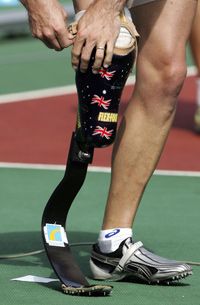Modern Prosthetic Limbs
How do modern prosthetic limbs compare to those of historical times? One major difference is the presence of newer materials, such as advanced plastics and carbon-fiber composites. These materials can make a prosthetic limb lighter, stronger and more realistic. Electronic technologies make today's advanced prosthetics more controllable, even capable of automatically adapting their function during certain tasks, such as gripping or walking.
While new materials and technologies have certainly modernized prosthetics over the past century, the basic components of prosthetic limbs remain the same. Let's go over some of these.
Advertisement
The pylon is the internal frame or skeleton of the prosthetic limb. The pylon must provide structural support and has traditionally been formed of metal rods. In more recent times, lighter carbon-fiber composites have been used to form the pylons. The pylons are sometimes enclosed by a cover, typically made from a foam-like material. The cover can be shaped and colored to match the recipient's skin tone to give the prosthetic limb a more lifelike appearance.
The socket is the portion of the prosthetic device that interfaces with the patient's limb stump or residual limb. Because the socket transmits forces from the prosthetic limb to the patient's body, it must be meticulously fitted to the residual limb to ensure that it doesn't cause irritation or damage to the skin or underlying tissues. A soft liner is typically situated within the interior of the socket, and a patient might also wear a layer of one or more prosthetic socks to achieve a more snug fit.
The suspension system is what keeps the prosthetic limb attached to the body. The suspension mechanism can come in several different forms. For example, in the case of a harness system, straps, belts or sleeves are used to attach the prosthetic device. For some types of amputations, the prosthetic is able to stay attached just by fitting around the shape of the residual limb. One of the most common types of suspension mechanisms relies on suction. In this scenario, the prosthetic limb fits snugly onto the residual limb, and an airtight seal keeps it in place.
Though most prosthetic limbs have these basic components in some form, each device is unique and designed for a specific type and level of amputation. Whether an amputation is above or below major joints, like the elbow or knee, makes a big difference in what type of prosthetic limb is required. For example, a transfemoral amputation -- an amputation above the knee -- requires a prosthetic device with an artificial knee, while a transtibial amputation -- an amputation below the knee -- allows the patient to retain the use of his or her own knee.
So now we know the components that make up a prosthetic device, but how are prosthetic limbs made, anyway?
